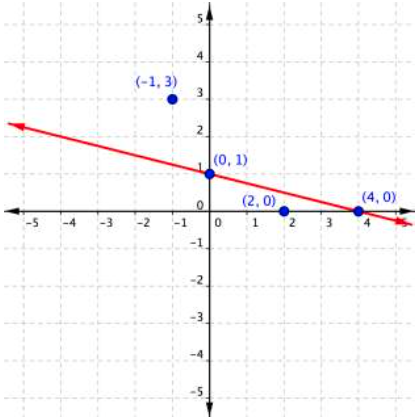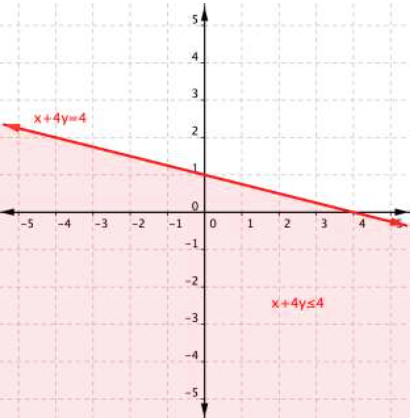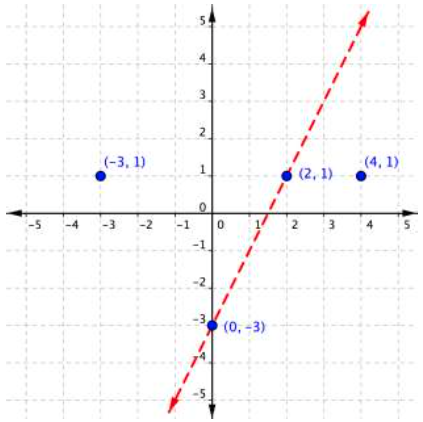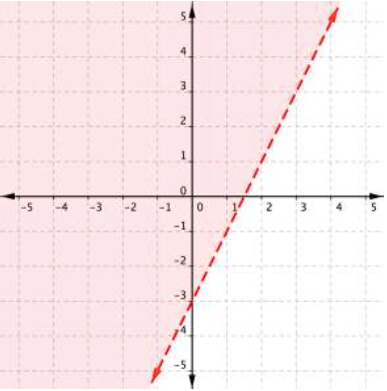Graph a Linear Inequality in Two Variables
Learning Outcome
- Identify and graph a linear inequality in two variables
- Graph the related boundary line. Replace the given inequality symbol, <, >, ≤ or ≥, in the inequality with the equality symbol, =, to find the equation of the boundary line.
- Identify at least one ordered pair on either side of the boundary line and substitute those [latex](x,y)[/latex] values into the inequality. Shade the region that contains the ordered pairs that make the inequality a true statement.
- If points on the boundary line are solutions, then use a solid line for drawing the boundary line. This will be the case for inequality with equality, ≤ or ≥.
- If points on the boundary line are not solutions, then use a dotted line for the boundary line. This will be the case for strict inequality, < or >.
| x | y |
| [latex]0[/latex] | [latex]1[/latex] |
| [latex]4[/latex] | [latex]0[/latex] |
 The next step is to find the region that contains the solutions. Is it above or below the boundary line? To identify the region where the inequality holds true, you can test a couple of ordered pairs, one on each side of the boundary line.
If you substitute [latex](−1,3)[/latex] into [latex]x+4y\leq4[/latex]:
The next step is to find the region that contains the solutions. Is it above or below the boundary line? To identify the region where the inequality holds true, you can test a couple of ordered pairs, one on each side of the boundary line.
If you substitute [latex](−1,3)[/latex] into [latex]x+4y\leq4[/latex]:
[latex]\begin{array}{r}−1+4\left(3\right)\leq4\\−1+12\leq4\\11\leq4\end{array}[/latex]
This is a false statement since [latex]11[/latex] is not less than or equal to [latex]4[/latex]. On the other hand, if you substitute [latex](2,0)[/latex] into [latex]x+4y\leq4[/latex]:[latex]\begin{array}{r}2+4\left(0\right)\leq4\\2+0\leq4\\2\leq4\end{array}[/latex]
This is true! The region that includes [latex](2,0)[/latex] should be shaded, as this is the region of solutions for the inequality. And there you have it, the graph of the set of solutions for [latex]x+4y\leq4[/latex].
Below is a video about how to graph inequalities with two variables.
https://youtu.be/2VgFg2ztspI
And there you have it, the graph of the set of solutions for [latex]x+4y\leq4[/latex].
Below is a video about how to graph inequalities with two variables.
https://youtu.be/2VgFg2ztspI
Example
Graph the inequality [latex]2y>4x–6[/latex].Answer: Solve for y.
[latex] \displaystyle \begin{array}{r}2y>4x-6\\\\\dfrac{2y}{2}>\dfrac{4x}{2}-\dfrac{6}{2}\\\\y>2x-3\\\end{array}[/latex]
Create a table of values to find two points on the line [latex] \displaystyle y=2x-3[/latex].| x | y |
|---|---|
| [latex]0[/latex] | [latex]−3[/latex] |
| [latex]2[/latex] | [latex]1[/latex] |

The inequality is [latex]2y>4x–6[/latex]. Find an ordered pair on either side of the boundary line. Insert the x and y-values into the inequality. If the simplified result is true, then shade on the side of the line the point is located.
[latex]\begin{array}{l}\\\text{Test }1:\left(−3,1\right)\\2\left(1\right)>4\left(−3\right)–6\\\,\,\,\,\,\,\,2>–12–6\\\,\,\,\,\,\,\,2>−18\\\,\,\,\,\,\,\,\,\text{TRUE}\\\\\text{Test }2:\left(4,1\right)\\2(1)>4\left(4\right)– 6\\\,\,\,\,\,\,2>16–6\\\,\,\,\,\,\,2>10\\\,\,\,\,\,\text{FALSE}\end{array}[/latex]
Since [latex](−3,1)[/latex] results in a true statement, the region that includes [latex](−3,1)[/latex] should be shaded.
The graph of the inequality [latex]2y>4x–6[/latex] is:
Below is a video about how to graph inequalities with two variables when the equation is in slope-intercept form.
https://youtu.be/Hzxc4HASygUSummary
When inequalities are graphed on a coordinate plane, the solutions are located in a region of the coordinate plane which is represented as a shaded area on the plane. The boundary line for the inequality is drawn as a solid line if the points on the line itself do satisfy the inequality, as in the cases of inequality with equality, [latex]\leq[/latex] and [latex]\geq[/latex]. It is drawn as a dashed line if the points on the line do not satisfy the inequality, as in the cases of strict inequality, < and >. You can tell which region to shade by testing some points in the inequality. Using a coordinate plane is especially helpful for visualizing the region of solutions for inequalities with two variables.Licenses & Attributions
CC licensed content, Original
- Ex 1: Graphing Linear Inequalities in Two Variables (Slope Intercept Form). Authored by: James Sousa (Mathispower4u.com) . License: CC BY: Attribution.
CC licensed content, Shared previously
- Ex 2: Graphing Linear Inequalities in Two Variables (Standard Form). Authored by: James Sousa (Mathispower4u.com). License: CC BY: Attribution.
- Provided by: Monterey Institute of Technology Located at: https://www.nroc.org/. License: CC BY: Attribution.
